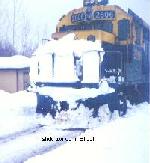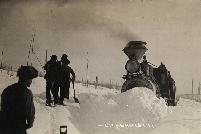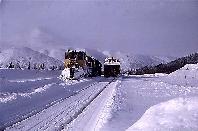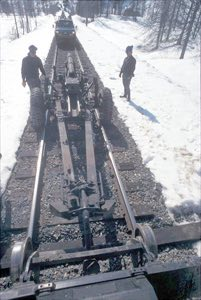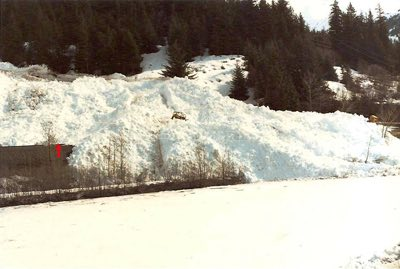
|
(Click on photos for a larger view)
Maintenance of Way (MOW) is hard (and sometimes dangerous) work. Add to it the harsh, unforgiving Alaskan winters and you have a chaotic situation that can bring operations to a standstill. Typical winter challenges for the Alaska Railroad are:
|
Over the history of the Alaska Railroad, a wide variety of snow removal equipment and techniques were used:
|
Snow and ice problems vary depending on the geographic location of the railroad. Some of the worst areas of the Alaska Railroad are:
Through Kenai Peninsula - mountains have snow 10-15 feet deep 50 mile stretch along Turnagain arm - avalanches and ice buildup From Anchorage to Canyon - 2-5 feet of snow, temperatures down to -50 degrees, big snow drifts due to heavy winds
A snow shed is a rigid snow-supporting structure for avalanche control or maintain passage where snow removal becomes impossible. They are constructed by a wide variety of materials such as wood, steel and concrete. The Alaska Railroad built snows sheds at Mile 53 and 75.5 between 1919 and 1920 to protect routes at naturally occurring avalanche chutes. The snow shed at Mile 53 was eventually bypassed in 1938.
See also:
- Work of Building Snowshed at Mile 75 is Rapidly Progressing
- Evolution of Avalanche Risk Reduction on the Alaska Railroad
- The History and Evolution of Track Machinery used for the purpose of Avalanche Clean up on the Alaska Railroad
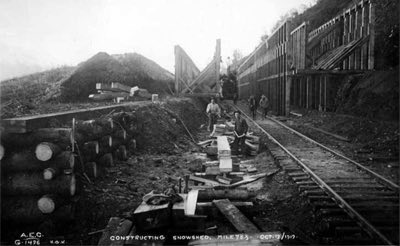 |
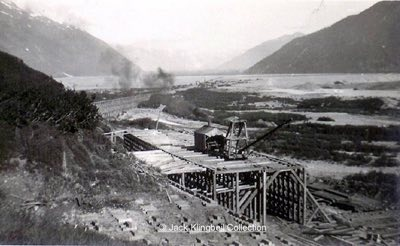 |
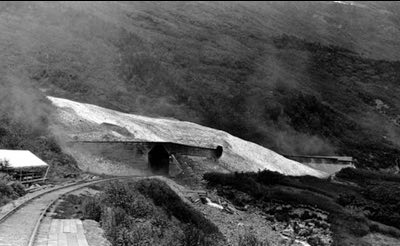 |
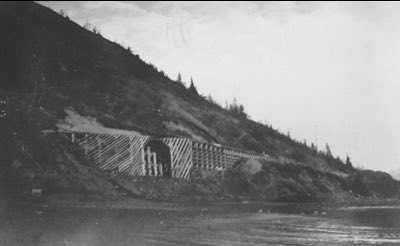 |
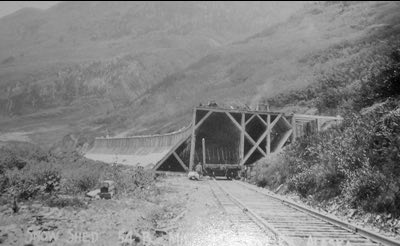 |
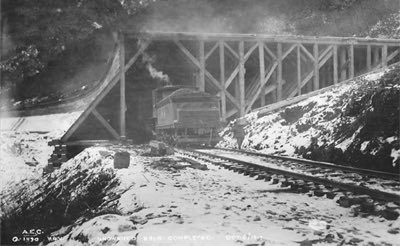 |
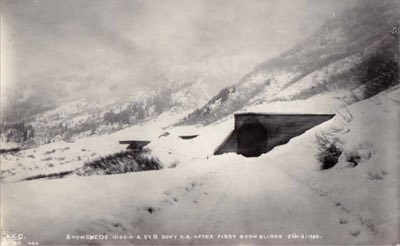 |
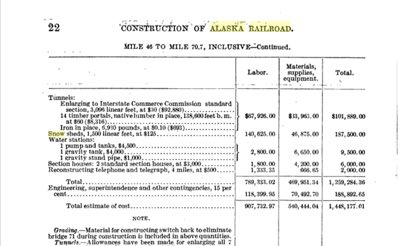 |
Snow Removal Equipment
Wedge Plows
Although the Alaska Railroad never used
wedge plows, for sake of completeness, they are mentioned here. The wedge
plow was basically a big wooden box, riding on freight trucks, and fitted with
a large, wedge shaped front. Three to six engines were coupled behind
the plow. The train would get a running start to drive the plow into the
drifts, pushing snow up and away from the tracks. While this design was
quite & effective and widely copied, it created huge walls of hard packed
snow next to the right-of-way. The next storm would fill in the plowed
sections, and the walls made it impossible to move the snow away from the rail.
The wedge plow also did nothing to remove snow and ice from between the rails,
which had to done to prevent derailments. Another machine, called a flanger,
was developed. This was basically a car equipped with a large-shaped mold
board. This rode the edges of the rails, breaking loose accumulations
of snow and ice. An operator had to ride the car, raising and lowering
the flanger wherever there was an obstruction in the rails. (Information courtesy
of Walthers)
Jordan
Spreaders
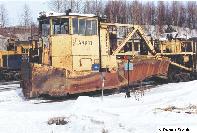 The
Alaska Railroad's Jordan Spreaders (numbers
5, 6, 7 and 8) were built by the O.F. Jordan Company in 1929. These units
are large, elaborate pieces of equipment with a high glassed-in cab for visibility,
a wedge front and wings at the side which can push snow well off the tracks
(see mechanical drawing for
further information). Spreaders are the largest pieces of snow removal
equipment to see frequent service. They carry their own footnotes in timetables
concerning maximum speeds, handling procedures and other restrictions.
When facing the task of serious snow removal on the Alaska Railroad, the Spreader
will use several locomotives
to push it.
The
Alaska Railroad's Jordan Spreaders (numbers
5, 6, 7 and 8) were built by the O.F. Jordan Company in 1929. These units
are large, elaborate pieces of equipment with a high glassed-in cab for visibility,
a wedge front and wings at the side which can push snow well off the tracks
(see mechanical drawing for
further information). Spreaders are the largest pieces of snow removal
equipment to see frequent service. They carry their own footnotes in timetables
concerning maximum speeds, handling procedures and other restrictions.
When facing the task of serious snow removal on the Alaska Railroad, the Spreader
will use several locomotives
to push it.
The spreader is also used by MOW crews to spread ballast along the track using the folding, hydraulically adjusted wings on either side. Spreaders have spanned the steam and diesel era, serving the nation for decades.
From Frank Dewey, Alaska Railroad locomotive engineer and veteran snowfighter (12/22/99): "The Jordan Spreader was the first "all season, all purpose tool", may be compared with the "Swiss Army Knife". It can slice, it can dice.
"They were first operated by pneumatic power as air pressure could be supplied indefinitely by the "pusher locomotive". As with most modern heavy equipment they were much later equipped with hydraulic power.
"Spreaders are most often operated in snow service with two pusher locomotives for better traction.
"Spreaders are now usually replaced for all but the heaviest snows by "ballast regulators" (see ballast regulators)
"Crews for "Snow Fleets" usually consist of:
- Roadmaster familiar with all the characteristics of the territory
- Heavy Equipment operator
- Conductor, who usually operates the "nose" plow
- Engineer (to really be the guy behind it all)
- Brakeman to clean switches and relieve the conductor on the "nose".
Crews are governed by the "Hours of Service Law" so may only work 12 hours at a time. Engineering personnel are not and may operated many more hours as needed (see ballast regulators)
Note: information on Jordan spreaders AEC, 1, 2, 3 and 4 is currently unknown.
"Spreaders #5 and #6: Retired about 1974-76 (one of them in Transportation museum in Wasilla) older style narrow cramped, wet and drafty cab. Crews liked them because they could wing faster and the pneumatic cylinders reacted much faster, but you had to know what you were doing.
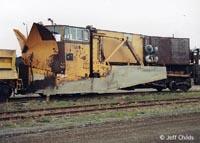 "Spreader
#7: The winter spreader" was built in the early 70s to replace spreader #5.
Number 7 has a full length house along deck which makes it top heavy, so it
rocks and rolls at critical speeds. After a roll-over derailment with the 3008
and the 1808? at MP 139 (1994?), it was rebuilt with four window GP40 style
side windows and a propane heater replacing the oil fired stove. The propane
stove requires four tanks to be mounted on the sides; kinda looks like bombs
hanging there.
"Spreader
#7: The winter spreader" was built in the early 70s to replace spreader #5.
Number 7 has a full length house along deck which makes it top heavy, so it
rocks and rolls at critical speeds. After a roll-over derailment with the 3008
and the 1808? at MP 139 (1994?), it was rebuilt with four window GP40 style
side windows and a propane heater replacing the oil fired stove. The propane
stove requires four tanks to be mounted on the sides; kinda looks like bombs
hanging there.
"Spreader #8: The summer spreader" was built about 1976 to replace spreader #6. Rarely used in wintertime, if used mostly on the "south end" with ice cutting edges installed on the front plow. Mostly used for summer ballast work because of better visibility.
"Spreader #9: Built for the Alaska Railroad in 2000."
From Bruce Gough, Alaska Railroad section foreman (12/29/03): "I took the spreader #9 from Portage to Seward on 12-23-03. Two to three feet of snow had our tracks buried and the spreader 9 did a good job of handling the white stuff. I took one photo out the window at Hunter. Pictures are not the greatest since was taken in other than ideal lighting with a digital camera."
Click here to see a 1.2MB video of spreader #9 clearing snow at the Spencer siding.
Click here to see a 636KB video of the joystick used to control the blades on spreader #9.
Click here to see a 588KB video of the rear view of the blade as it plows snow.
See also
- Spreader 2 at McKinley Park Station (1973)
- Spreader 5 in Anchorage (1975)
- Spreader 6 in Palmer (1987)
- Spreader 7 in Anchorage (1993)
- Spreader 7 in Seward
- Spreader 8 in Wasilla 11/1/18
- Spreader 8 in Fairbanks
- Spreader 8 in Fairbanks 8/12/20
- Engineering drawings for spreaders 1, 2, 3 and 5&6
- Historical video of Jordan spreader plowing snow
- Spreader 5 builder's plate
- Spreader 8 2022
- Spreader 9 2022
Russell
Plow
Railroads were always seeking more
economical ways to fight snow, so it wasn't long before all three designs
were combined into one car. By the early 1900's, the Russell Car
and Snow Plow Company of Ridgeway, Pennsylvania, was a leading supplier
of wedge-type plows. The design had been modernized with a cupola
and seats for an operator, headlight for night operations and a pair of
air-activated side wings to push snow up and away from the side of the
tracks. Wooden bodies were still common, but within a few years, all-steel
plows had proven to be more durable. Both single track (as depicted
by this model) and double track (which had one side of the blade enclosed
to prevent snow from being pushed on to an adjacent track) were offered.
Russell continued supplying steel plows to virtually every railroad that
fought snow until early 1950's.
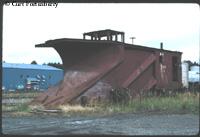 Since
they only see seasonal use, which varies according to the severity of the winter,
and were built tough, many of these veteran snow-fighters are still in service.
Often the only modifications have been a conversion to diesel-type headlights,
installation of radios and the addition of an MU plug at the back to provide
electrical power. Air for the wings and brakes is supplied by the locomotive,
and some roads have equipped engines for plow service.
Since
they only see seasonal use, which varies according to the severity of the winter,
and were built tough, many of these veteran snow-fighters are still in service.
Often the only modifications have been a conversion to diesel-type headlights,
installation of radios and the addition of an MU plug at the back to provide
electrical power. Air for the wings and brakes is supplied by the locomotive,
and some roads have equipped engines for plow service.
In operations, plows are run as extra trains, but usually have rights over all other trains on the line, because of their important mission. If things are bad enough, they may be the only trains moving at all! Weather and track condition reports are made by area trains crews, and the plows are will be ordered by the chief dispatcher when conditions warrant. The crews are well trained and include the plow operator, the division roadmaster (who knows the geography and track conditions firsthand), and the engine crew. Usually several crews are trained to provide relief if conditions persist. In the steam era, a camp car with a gang of workers and a tool car carrying shovels and repair parts, often accompanied the plow. If the plow became stuck or the drift was too deep, the crew would shovel away the snow by hand until the plow could handle the job. Today, construction equipment will be brought in to clear the line if the plows can't handle it. (Information courtesy of Walthers)
From Frank Dewey, ARR locomotive engineer (12/22/99): Never really used, it was put to pasture nearly as soon as it arrived. It seems that the ARR received it new from US "postwar stocks". Russell plows were very successful in the eastern and plain states at removing snow drifts. The ARR does drift in only a few areas, such as from Broad Pass to Summit, but the plows mounted on the locomotives work just fine for most of it.
"The snow on the plains and in the east drifts from large open areas and fields in the cuts that the railroads right-of-way ran through, creating very long and hard snowdrifts. The push plows like the Russell work just fine as they are "rammed" into the drift time and again until they break through.
"Here in Alaska we experience less drifting and we have many curves. It seems that they operated the Russell only a few times before becoming frustrated with it always derailing on curves. The Russell and the SD70MACs have something in common. The distance from the front-center point of the plow to the bolster is far enough to cause the plow want to travel in a straight line, thereby pulling what is behind off the rail."
From John Henderson (7/14/00): The ARR had a pair of wooden Russels and then a pair of steel ones. In the late sixties I had the opportunity to talk to the Chief Mechanical Officer of the ARR and asked about the steel Russels. When I did I got the following story from the fellow, a former employee of the Bangor & Aroostock RR.
In the mid sixties the ARR had "one of those Winters" when the CATS, Jordans, and even the ROTARIES couldn't keep the railroad open. The CMO asked why they weren't using the Russels and got a reply something to the effect that, "They don't work!!!!" Research found that an employee had been killed in one of the wooden ones when it hit a slide filled with trees.
The CMO ordered the # 4 Russel brought in to the shops and made road worthy (glass replaced, wipers working, etc.). The CMO then asked for a volunteer train crew to push the Russel with him operating it over the railroad. He got it IF the crew was permitted to remain in the REAR UNIT of the four F units assigned to the plow train.
The conclusion of the story I heard was that the plow train headed out of Anchorage for Seward and got to FAIRBANKS within the 16 hour "hours of service" rule. I don't really believe that time line but I do believe the general content of the story. It matches photos I have of a derelict and serviceable Russell # 4.
Also:
- More photographs and information
- Engineering drawing 1&2, 4
- Photo of a Russel plow in front of the old Curry hotel
- Photo of the Russel plow in 1957
- Russel plows are still used today! Click here to see a video of a Russel plow being used on the Strasburg Railroad 3/16/16
- Historical video of Russell plow in operation
- Russel plow #3 photo
Rotary
Plow
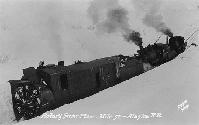 Rotary
plows, developed in 1883 by Orange Jull and marketed by the Leslie Brothers,
are the largest of pieces of railroad snow fighting equipment. These behemoths
can throw snow hundreds of feet from the tracks and can clear a swath through
a dozen or more feet of snow. Due to operating expenses, however, they rarely
see service. A measure of their importance can be seen in the fact that Union
Pacific and BNSF each have no fewer than 10 rotaries available. Today most rotaries
are powered by electricity supplied from a trailing locomotive, a specially
converted power car, or an internal diesel engine. Several steam powered rotaries
survive, and a few are operable today.
Rotary
plows, developed in 1883 by Orange Jull and marketed by the Leslie Brothers,
are the largest of pieces of railroad snow fighting equipment. These behemoths
can throw snow hundreds of feet from the tracks and can clear a swath through
a dozen or more feet of snow. Due to operating expenses, however, they rarely
see service. A measure of their importance can be seen in the fact that Union
Pacific and BNSF each have no fewer than 10 rotaries available. Today most rotaries
are powered by electricity supplied from a trailing locomotive, a specially
converted power car, or an internal diesel engine. Several steam powered rotaries
survive, and a few are operable today.
From Frank Dewey, ARR locomotive engineer (12/22/99): "The Alaska Railroad's rotary #3 was built by Cooke Locomotive Works, in April 1930 (see mechanical drawing for further information). It was operated under steam well into the 1960s. Converted by the ARR to electric operation with (2) EMD D-47 traction motors geared to the main drive shaft. Originally powered from a F7B unit that would have its main traction generator disconnected from its traction motors. Power cables would then be strung through the end door into the rotary and connected to terminals there. To ease the laborious procedure, the ARR had (3) 1800 locomotive converted to MU controlled power mates with the installation of (4) power receptacles under the front walkway, and a second MU plug on the front MU stand and a RSS switch in the electrical cabinet." Although totally operational, it was last used in 1995.
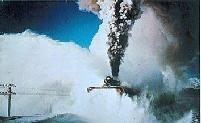 From
Rick Leggett, ARR General Roadmaster (5/26/99): "I
know it [rotary #3] was built for the CMStP&P (Milwaukee Road). Our
electrician Sam Lane tells me his father, a retired Milwaukee electrician himself,
recognized it. We last used it about 8 years ago, and that was the first
time. Ironically, Sam was hurt while readying it for service (caught his
hand in a door, as I recall). It was originally steam powered and was,
I believe, a genuine Leslie plow. The Milwaukee converted it to electric
powered (generated on board the first loco behind it). There is one feature
of this plow that I find intriguing; it is the only piece of railroad
equipment I have ever been in with a balcony. When one leaves the cab
he steps out onto a platform from which a stairway descends to the machinery
deck. It sure looks like a balcony to me."
From
Rick Leggett, ARR General Roadmaster (5/26/99): "I
know it [rotary #3] was built for the CMStP&P (Milwaukee Road). Our
electrician Sam Lane tells me his father, a retired Milwaukee electrician himself,
recognized it. We last used it about 8 years ago, and that was the first
time. Ironically, Sam was hurt while readying it for service (caught his
hand in a door, as I recall). It was originally steam powered and was,
I believe, a genuine Leslie plow. The Milwaukee converted it to electric
powered (generated on board the first loco behind it). There is one feature
of this plow that I find intriguing; it is the only piece of railroad
equipment I have ever been in with a balcony. When one leaves the cab
he steps out onto a platform from which a stairway descends to the machinery
deck. It sure looks like a balcony to me."
From Dick Brown, Milwaukee Shop Electrician Apprentice (12/29/08): "The following comments come from my feeble memory of events while working at Milwaukee Shops of the Milwaukee Road as an Electrician Apprentice from 11-56 to 8-61. These comments are my personal recollection of the construction of a rotary plow that was built in the Milwaukee Shops sometime during my Apprenticeship on the Milwaukee Road. This may be the Plow Unit referred to in the web page, "SNOW FIGHTING ON THE ALASKA RAILROAD" by Mr. Rick Leggett. This information may augment the information presented in the Web Page referenced and are not intended to alter or supersede Mr. Leggett’s comments.)
"I recall that one of the projects that I briefly worked on as an Electrician apprentice, was the construction of a rotary snow plow in the mid/late 50’s, however I can’t pin down the exact time frame.
"I do recall the balcony or catwalk, mentioned in Web page referenced above. My recollection is that this consisted of a platform with hand rails and a ladder between the Operating Cab level and the floor level of the car body.
"The entire fabricated steel body was new construction with the exception of the frame, trucks, and the rotary blade assembly which was salvaged from an old Steam Driven Rotary Plow. I suspect that the heavy duty frame and trucks may have been salvaged from a large steam locomotive tender. The Milwaukee Shops were very good at salvaging from old equipment to make something new. I also recall that the frame was a very large frame of heavy cast-iron construction. (side line – They also salvaged smaller steam locomotive tender frames to build several yard cabooses. This worked very well, the frames and trucks were heavy duty construction and stood up to the heavy switching duty on the Air Line Hump in Milwaukee. One of these Yard Cabooses survives today at the Trolley Museum in East Troy, Wisconsin.
In the new design the rotary blade formerly driven by steam, was powered by four Diesel-Electric Locomotive traction motors. These drive motors for the rotary blade were arranged in the car body on both sides of a long, large diameter drive shaft that was located on the longitudinal center line of the plow frame. The traction motors were arranged alternately on each side of to drive the shaft with direct gearing similar to the motive gearing of the locomotives. These motors were powered from a Diesel-electric unit coupled directly behind the plow unit. The third unit of this consist was a Diesel-electric pusher. The pusher and the rotary blade were controlled by the Locomotive Engineer from the front of the Plow Cab via the existing train line control system. This system is common to all Diesel-electric locomotives to allow control of multiple Diesel Electric Units from the leading locomotive Cab."
From Frank Dewey, ARR locomotive
engineer, (12/22/99): "Rotary X-900212 (ex
MILW) on display at Potter Section House (never numbered or operated by
the Alaska Railroad) was purchased when the Milwaukee's "Western Lines"
were shut-down in the 1970s. It was used in the Bitterroot Mountains of
Idaho. ARRC engineer Steve Cain, a former MILW engineer, was one of the
last Milwaukee engineers to operate it "under wire" out of Avery, Idaho.
Proof still exists in the Catenary Platform on the rear roof section and
that it is powered with a "Bi-polar" motor.
"Rotary Snowplows are rarely used any more on the ARR as Caterpillar D-6s respond faster, can move snow much faster and need to only have one operator. The last time rotary #3 was used, was after a very heavy snow fall that plugged sidings during a heavy snow season in which the berms were too high and frozen to be moved by either cat or spreader. The rotary could throw the snow 300 feet over the berms, but in most conditions Cats, regulators and spreaders can do a much better job quicker and cheaper."
From Jason Kuehn, ARR historian, (9/20/05): "Here is the story of Rotary #4 as I know it: Rotary #4 is a former MILW rotary plow that was based out of Tacoma and purchased by the ARR after the MILW's Pacific extension was shut down in 1980. (Somewhere in my archives I have a black and white photo of this rotary coming back into Tacoma the final spring of the Milwaukee pacific extension.) I don't know that the ARR ever actually used the rotary and it was retired probably about the time the photo of the week was taken and placed in the display at the Potter section house."
From Don Marenzi, ARR historian, (2/7/12): "Here's my first shot at an ARR Rotary Snow Plow roster:
1 Built as Alaska Central # 1 in 11/1905, by ALCo (Cooke works) builders # 28613. Became Alaska Northern Ry. # 1 to Alaska Engineering Commission # 1 in 1917. Became Alaska RR # 1 in 1923 described as in fair condition as of 10/1929. Scrapped in September 1946. (retired when some Caterpillar bulldozers were transferred to the ARR from the Army)
2 Built as Colorado Midland RR # "B" in January 1900 by ALCO - Schenectady (Sold by Leslie Brothers, builders # 58.) Loaned by the C.M. to the Colorado Springs & Cripple Creek District Ry. during December 1913. To Alaska Engineering Commission # 2 in 1919. Became Alaska RR # 2 in 1923. Burned in engine house fire on July 18, 1926 at Curry. Rebuilt by the ARR in 1926-27. Apparently a larger diameter 'plow wheel' was used during the rebuild. Described as in good condition as of 10/1929. Retired in May 1959. Sold for scrap in 1959. Was disliked by the crews and known as "The man killer".
3 Built as Alaska RR # 3 by ALCo-Cooke in 1930, Alco builders # 66424 (there is some evidence that this unit was originally ordered and then canceled by the Northern Pacific RR; but no definite proof of this.) Converted to diesel power in 1967. Rebuilt in 1985 (by ARR). Retired 20xx to display in Curry 20xx
4 Built as Chicago Milwaukee & St.Paul # 10 by ALCo (Cooke works) builders # 45425 to Chicago Milwaukee St. Paul & Pacific (Milwaukee Road) # X-900207. Converted from steam to electric power in 1958. Sold to Alaska RR # 4 in 1981. Not repainted, but "patch" lettered ARR 4. Received in poor mechanical condition. Not used, stored in Anchorage. Retired 1984. Donated in March 1985 to Alaska State Parks, stored in Anchorage until display site was ready. To display at Potter. 19xx.
For the sake of completeness here are three additional rotary plows that have 'some connection' to the ARR, but were never used by the ARR:
U.S. Army # number not known Williams Bros. Machinery Co. Built in March 1954. (Bros. was a name, not the word 'brothers' abbreviated). Plow "snow chopper/blower/rotary" this unit had a pair of six wheel trucks the U.S. Army tested it on the Great Northern. Original reason for purchase or location for the Army unknown. To Army base at Ft. Lewis, WA. The ARR inspected it at Fort Lewis in the early 1960's. The ARR didn't want it "as it had too many moving parts", so declined the offer to transfer it from the Army to the ARR. Sold to Great Northern # X-1500 in 1966. Became Burlington Northern # X-1500, then renumbered # 972556. BNSF # ? sold to Red River Valley & Western # 113 (Minnesota); in service.
Copper River & Northwestern # X-1 built by ALCo (Cooke works) in 11/1908 builders # 43669. Left in Cordova after CR&NW abandonment. Transferred to US Army but not used by them during World War 2. After World War 2 the Army transferred ownership of it's railroad equipment at Cordova to the ARR. I've never seen any evidence that this plow was actually moved to the ARR, but they may have technically owned it. Probably scrapped in the late 1940's, possibly at Cordova.
Santa Fe # 199398 Built by Cooke in December 1892 (Leslie Bros. builder # 44 as AT&SF # 99802. Later renumbered # 199802 in 1911 then renumbered # 199398. Reportedly the ARR inquired with the AT&SF about acquiring it in 1948. The plow had just experienced mechanical failures, and the Santa Fe decided to rebuild it instead of selling it. It was retired in 1958 and it's rotor blades, shroud and other parts were used to construct AT&SF rotary # 199361 using a former tender for the body. Now owned by BNSF: still painted as AT&SF #199361, in storage in Topeka, KS.H
On 9/11/20 Bill Haggart says of the rotary on static display at Potter station south of Anchorage, "We bought that years ago. Never blew a speck of snow in Alaska. The Alaska Railroad thought they needed a second rotary but upon inspection on arrival figured out it wasn’t any newer or in better shape than what we had. After foreman started to pull it out of mothballs a couple of times they ended up on a static display."
On 3/11/21 Bill Haggart added, "It was labor intensive to keep it out and running. When it was converted from steam it had a locomotive traction motor installed to run the blower wheel it required a locomotive to power the blower the fan was on an electric clutch that had to be kept between certain RPM’S if you got an over speed it would shut down and require getting back up to speed during this time you could plug machine up. DK did a good job of feathering the RPM's to limit the over-speed governor kicking in and even PS came along, because he had never been out with a rotary either."
Added 11/27/23: The prototype Rotary was converted from steam to electric sometime in the 1960s, the rotary wheel is connected to a huge motor (I believe it's a traction motor) and the power for the rotary came from a B unit. The first was 1069 I believe, one if the RF1B units followed by F7B 1507, these units had the cables for the traction motors rerouted for the rotary. After the F units were retired a couple of GP7U 1800s were fitted with the MU connections for the rotary. Locomotives for the rotary train could be anything from 1000, 1500, 1800, 2000, 2500, and 3000 depending on the decade. As for this rotary scheme a black and yellow 1507 with a pair of 2500s would be accurate. Usually an outfit car or caboose brought the rear up. Interesting note, the two homemade cabooses built from WWII troop kitchen cars were designed for rotary service, they are just a little bit narrow compared to other cars of the era. With that and steel construction it made for a good combination.
Also:
- Historical video of Rotary Plow in operation near Anchorage
- Cumbres and Toltec Rotary in action
- Rotary roster 8/9/44
- David Smith's photos of Rotary #3
Operations rotary photos from the James Sava collection
ARR Rotary History (provided by John Henderson)
- Rotary #1: Built for the Alaska Central RR
- Rotary #2: Ex Colorado Midland "B": Probably little more than the blade and housing remained when it was retired and scrapped in the late fifties. Reports from the early 1930's (I have copies with dates) indicate this rotary was involved in an accident where the frame broke and the boiler wound up on the ties. The best guess I have is the # 2 got its steel frame and body as a "repair" after this incident.
- Rotary #3: while it was sold new to the ARR as indicated by its builder's plate, it was almost certainly not built for the Alaska Railroad. Checking the construction number and having had access to the correspondence files of the General Manager, I have come to the conclusion that the # 3 was built for the Northern Pacific and then canceled or refused. A check of serial numbers will show the ARR # 3 rotary in a group of serial numbers used for NP rotaries. A letter in the General Manager's files refers to, "the rotary plow we purchased from the Northern Pacific last year." The date of the letter shows it can ONLY refer to the # 3. NP historians have not been able to confirm or deny my conclusion. Rotary # 3 was converted from seam to electric in 1967. I photographed the rotary cab in Anchorage in September 1967 and was told it was being converted at that time. It is still on ARR's roster.
Also see:
- Mike Weatherell's photo collection of rotary #3 on the rail
- Rotary near Curry
- Additional information including builder's photo for Rotary #3
- A rotary bucking through a snow slide
- Another photo of a rotary near Curry
- Engineering drawings for Rotary nos. 1, 2 and 3 (also see drawings for 1 and 2)
- 1.2MB movies of the rotary throwing snow: 1, 2, 3, 4
- John Parys's photos of a rotary in Whittier during WWII: 1, 2
- Deane Motis photo of Rotary #3 in Anchorage
- Steve Drassler's photo of Rotary #3 on the line
- Colorado Midland "B" rotary engineering drawing
- William A. Gibson's photo of Rotary #2
Recoilless
Rifle
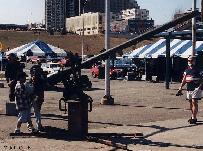 Avalanches
pose a very dangerous threat to the Alaska Railroad. Large amounts of
snow can slide across the tracks, causing the rails to bend or move. An
oncoming train will hit the newly formed snow bank and a serious derailment
can result. The destruction that avalanches cause can shut operations
done for hours or even days. An avalanche on January
31, 1998 took out 200 feet of track, over turned three coal cars and closed
the route for several days. To help manage the heavy snow accumulation from
the hills and mountains above, the Alaska Railroad uses a 105mm
recoilless rifle. Before the snow accumulates into an unmanageable
menace, workers fire a round at an overhang or drift and knock it down.
Avalanches
pose a very dangerous threat to the Alaska Railroad. Large amounts of
snow can slide across the tracks, causing the rails to bend or move. An
oncoming train will hit the newly formed snow bank and a serious derailment
can result. The destruction that avalanches cause can shut operations
done for hours or even days. An avalanche on January
31, 1998 took out 200 feet of track, over turned three coal cars and closed
the route for several days. To help manage the heavy snow accumulation from
the hills and mountains above, the Alaska Railroad uses a 105mm
recoilless rifle. Before the snow accumulates into an unmanageable
menace, workers fire a round at an overhang or drift and knock it down.
From Frank Dewey, Alaska Railroad locomotive engineer (12/22/99): "In 1998 the (2) ARRC 106mm recoilless rifles were retired and replaced with an ex-US Army 105mm howitzer with Hy-rail gear mounted on the original gun carriage. The reason was that the "Korean War" vintage weapon had run out of ammunition. Supplied to many third world nations the 106mm stockpiles were used up by Viet Nam and numerous other wars. In 1990 the ARRC paid for the last 3000 rounds to be refurbished for avalanche control.
"The howitzer and ammunition is kept at Tunnel Section House at MP51, between Slide Zone 49 and Slide Zone 53. It is safe there as the only way to get there is by rail or helicopter. Tests were conducted by the ARRC and the US Army/National Guard with a 105mm howitzer mounted on a 50 ft. flatcar, caboose and with a military gun crew to operate it. Now you know that there is a prototype for those HO Scale ROCO guns!
"Originally, the gun was a home made "thing" that used either propane or acetylene gas for propellant. You might say "the mother of all potato guns" to lob an explosive package into the slide chute. Not exactly long range or accurate. It was replaced with a 75mm recoilless, but ammo stocks were already low and the more powerful 106 was soon available.
"Sometimes the ARR will use helicopters to bomb the slide areas."
From Rick Leggett (2/20/20), "The U.S. Army owns the actual guns and the ARR, as well as many ski resorts, can only lease the guns. The ammunition has to be purchased. The 105 recoilless was the preferable gun for avalanche control across the nation for many years, but in the late 90's the Army ran out of ammo for it so most (all?) entities that leased guns for avalanche control....had to switch over to the less mobile Howitzer (more ammo in stock). Here's a picture of hi-rail gear set up on one of the ARR howitzer's to tow it down the track, whereas the old recoilless could be put on the deck of a hi-rail boom truck...and transported in that way."
"Here's a slide that two dozers are working. The red arrow shows the track."
"Helicopter bombing is used when the weather and other conditions permit and is actually preferable...because the explosive can be placed with greater accuracy."
See Also:
- Daisy Bell Training (helicopter carrying charge)
- Railroad Crew Uses Howitzer Cannon to Trigger Huge Avalanche - Railroad Alaska
- Railroad Uses Howitzer Cannon to Cause Avalanches | Railroad Alaska
- Turnagain Pass Avalanche Forecast
- Evolution of Avalanche Risk Reduction on the Alaska Railroad
- Greg Luppen's avalanche control
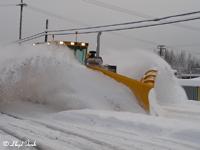 From
Frank Dewey, Alaska Railroad locomotive engineer (12/22/99): "Originally
developed to "regulate" ballast evenly over the ties before the tamper tamps
it under them, the BR has become the most versatile tool in the rail inventory.
If the spreader was the "Swiss Army Knife", this is the "Vege-matic". Through
the years the regulator has been given plows, wings and a hydraulic broom. They
have grown larger and more powerful and in Scandinavian countries are as large
as a locomotive and are powered by EMD 645 engines.
From
Frank Dewey, Alaska Railroad locomotive engineer (12/22/99): "Originally
developed to "regulate" ballast evenly over the ties before the tamper tamps
it under them, the BR has become the most versatile tool in the rail inventory.
If the spreader was the "Swiss Army Knife", this is the "Vege-matic". Through
the years the regulator has been given plows, wings and a hydraulic broom. They
have grown larger and more powerful and in Scandinavian countries are as large
as a locomotive and are powered by EMD 645 engines.
"In snow service the BR is equipped with a very large plow and much larger wings than for ballast service. They can operate with a crew of one or two people, who are not covered by the "Hours of Service Laws". Unless it is a very heavy wet snow fall the BRs can handle it with much more efficiency. At Tunnel, Divide, and Hurricane the BRs can be teamed with Cats to do a very through job of cleaning the rail.
"The romance of rotaries and spreaders has been replaced by the newer "BR" and their operators. As an engineer, I like the work that can be done and is done by the unsung heroes the "skinners and operators"."
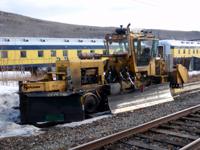
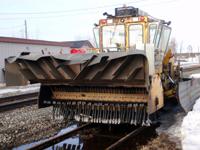 Added
4/19/12: Taken in Nenana on 4-14-12 these photos
by show a Ballast Regulator staged on a ready track. This track is north
of the historic depot and across the main from from the section house.
Note the extension cords running to the machine. These
cords provide power to a series of heaters often referred to as a "winter
package". Engine block heater, hydraulic tank heater, oil pan heater,
battery blanket, battery maintainer, etc... Most of these installations
require a minimum of a dedicated 20 amp service as total draw can exceed over
5,000 watts. This Ballast Regulator is equipped with rigid side wings
used for snow removal. They still move in and out, up and down, but are
not the typical wing blades found on a regulator working ballast service.
In the dark of the winter with high daily temperatures of -20 degrees F, this
little machine is responsible for clearing snow from the many crossings, switches
and the guardrails of the bridge in Nenana.
Added
4/19/12: Taken in Nenana on 4-14-12 these photos
by show a Ballast Regulator staged on a ready track. This track is north
of the historic depot and across the main from from the section house.
Note the extension cords running to the machine. These
cords provide power to a series of heaters often referred to as a "winter
package". Engine block heater, hydraulic tank heater, oil pan heater,
battery blanket, battery maintainer, etc... Most of these installations
require a minimum of a dedicated 20 amp service as total draw can exceed over
5,000 watts. This Ballast Regulator is equipped with rigid side wings
used for snow removal. They still move in and out, up and down, but are
not the typical wing blades found on a regulator working ballast service.
In the dark of the winter with high daily temperatures of -20 degrees F, this
little machine is responsible for clearing snow from the many crossings, switches
and the guardrails of the bridge in Nenana.
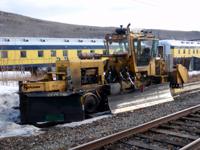 |
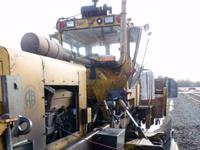 |
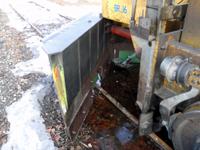 |
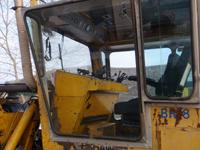 |
Added 4/6/21: Mark Butler provides a nice video of a ballast regulator doing "snow removal an hour in advance of the southbound Aurora on Easter Sunday. About 24 inches of fresh powder fell after the Aurora came north on Saturday".
Plows
From Frank Dewey, Alaska Railroad locomotive
engineer (12/22/99): "The SD70MACs will only have
"standard" EMD factory plow attached. Another snow fighting tool that the ARRC
uses is the plow designed by the ARR for the GP49s and since retrofitted to
many GP40-2s. At 25 mph one of these plows can throw snow farther than the spreader.
The design was so good that EMD adopted the design as a factory option. The
rake of the plow is so radical that it extends back into the main frame rails,
so only vertical ladder steps can be used. By FRA regulations this restricts
these locomotives from being used in yard/ local switching, so they can only
be attached to "Road" locomotives."
Jet
Blowers
I'd be the most popular guy in
the neighborhood if I had one of these beauties in my garage! Thanks
to Ben Butler for providing photos of this unit clearing snow in Whittier
on February 7, 2000.
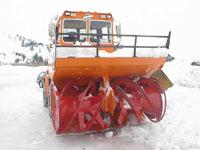 |
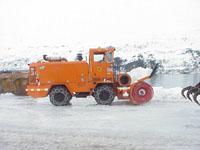 |
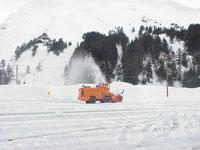 |
| Number | Type | Size | Status (as of 6/6/01) |
| S-23 Snow blower | Sicard | 4 wheel drive | Out of Service |
| S-24 Snow blower | Oshkosh | 4 wheel drive | Out of Service |
| S-25 Snow blower | Oshkosh | 4 wheel drive | Serviceable |
| S-26 Snow blower | Stew/Stev | 4 wheel drive | Serviceable |
| Jet Snowblower | ESSCO | 34 Jet | Serviceable |
See also BR21 Jet Snow Blower in the Maintenance of Way photo section
Switches
On November 30, 2000 the Alaska
Railroad installed the first set of 80 heated, radio-controlled switching
systems at Hurricane. No longer will a member of the train crew have
to get off the train, chip ice and sweep snow off the switches and manually
set the switch. The switches are activated by the engineer on board
the train and will no longer be activated by hand. These switches
are kept free of snow and ice by a heater powered with a combination of
wind and solar energy. All switches will be installed by 2004 for a total
cost of $60 million.
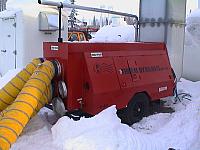 |
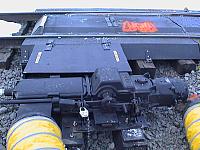 |


Whittier: After an incident where a Cat 988 Large Wheel Loader plowing snow almost went for a swim in Prince William Sound, the railroad put Jersey barriers in place as well as a designated snow dumping ramp.
See also
-
Winter Operating Conditions on the Alaska Railroad (circa 1963)
- Picture of the Week 1/23/12
- Picture of the Week 2/6/12
- Picture of the Week 1/7/19
- Switch cleaning Picture of the Week 3/5/12
- Snowfleet at Broad Pass 12/23/17
- Mike Gerenday's snowfleet chase
- Historical documentation
- Assignment of snow removal equipment in the Whittier Terminal Yard
- New York Central System's inquiry into types of snow equipment used
- Alaska Railroad rotary Snow Plows Nos. 2 and 3
- Russell Snow Plow Co. providing brief specifications
- Urgency in receiving Russell Snow Plow
- Roundhouse response excessive
- Train Rules Regulating Handling of Snow Plows
- Big Machines Defeat Big Snow Troubles
- Greg Luppen's avalanche photos
- January 17, 2023 avalanche
- Spreader 9 blasts its way to MP345
- Afternoon Portraits of Snowfleet
- PistenBully 600 spotted in Whittier
-
S2 right side, left side, 10/25/48
- S9 right side, left side, acquired in 1957
- S24 right side
Page created 12/20/98 and last updated 6/16/25
